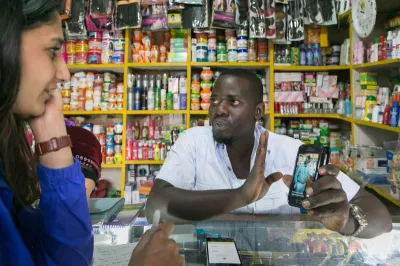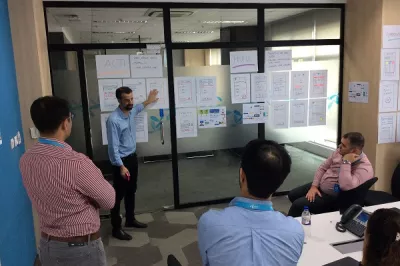3 Customer Insights for Better Mobile Money UI/UX in Pakistan
Smartphone use in Pakistan has grown steadily over the last three years, from 13 percent to 31 percent. This trend is expected to continue, thanks to low cost devices and increased data coverage; however, not all Pakistanis are enjoying the benefits of smartphones like greater access to financial services. Low-income, less educated, and female customers lag in smartphone adoption and ownership. For this reason, GRID Impact designed a mobile money smartphone interface to target those specific segments of the market, whose unique needs and behaviors are traditionally ignored in the creation of smartphone applications.
Tasked with building mobile money service that was easy and appealing to use for low-income and lower-literacy women, we decided to leverage the highly visual interfaces of smartphone apps to create an accessible experience. Our customer research involved more than 60 users and focused on the way women made sense of and used mobile technology in their everyday lives. It revealed several insights that influenced the design choices and principles of the user interface we developed. These insights, some of which surprised our team, should also help the financial inclusion community to better serve Pakistani women.
Interfaces should reflect the aspirational nature of smartphones
Our findings revealed that smartphones represented greater connectivity and social status to many Pakistani women, and that the aspirational nature of smartphones influence how these women used them. For example, few women used a smartphone for all of their mobile needs. Many used their smartphones for entertainment and non-essential purposes (Facebook, watching videos, etc.), while reserving their utility needs for their feature phones (calling, messaging, mobile money transactions, etc.), which they find faster to type on and easier to navigate. Furthermore, even though non-English speaking customers had the ability to switch the language on their phones to Urdu, they chose not to. They preferred using apps that displayed left-to-right English text instead of Urdu (commonly written and read right to left), as English aligned with the aspirational nature of the phone.
Since smartphones were representative of social ambitions, we created an app that, although accessible for all users, especially capitalized on the aspirations of users new to mobile money. Our onboarding screens presented users with a suite of options beyond simply transferring funds, introducing nascent users to more sophisticated mobile financial services than they had previously enjoyed. Offering users the chance to link the app to social media provided an added allure. Understanding our users — and how they conceived of mobile technology and platforms — was critical to creating an attractive intervention.
Not all customers want to use their mobile money apps independently
Pakistani women’s movement beyond the house is sometimes restricted by conservative community norms, so the true value of mobile money is that it allows them to conduct important daily business from their homes. For this reason, our goal was to design an interface that made it easy and intuitive for women to use mobile money on their smartphones at home, without the need for over-the-counter support. We created “contextual help” — voice instructions at any step of the process — that provided feedback within a transaction to build confidence and move past barriers. Through our research, however, we also realized that not all customers want to use mobile money apps independently all of the time. In some cases, they prefer over-the-counter support. If something goes wrong, they trust the agent to resolve the issue. This served as a reminder that better (and necessary) technology is no substitute for strong, in-person relationships.
In this example below, a user is logging in for the first time and has no balance, so the assistant suggests that they find a shop. The user is also greeted by name to help them feel more comfortable.

X doesn’t always mark the spot
Our prototype testing focused on transaction flows and the detailed design choices about icons, visual language and buttons. User feedback informed our final design choices and revealed interesting mental models about visual cues in mobile money interfaces in Pakistan.
For example, research revealed surprising preferences for the “X” symbol. “X” is a good choice to cancel a transaction or step because people associated “X” with something being wrong or a mistake. However, “X” was not a good choice for closing, such as when we wanted a customer to close a dialogue box. Because many low-income customers in Pakistan leapfrogged personal computing devices, using design metaphors rooted in desktop computers, such as “X” to close, did not make sense. As another example, the help icon evolved from a question mark to a man wearing a headset to a woman wearing a headset, which was the most easily recognizable visual for customer support.
Many of our test users did not understand the UI interface of tapping “X” to exit a screen or dialog box, but they were comfortable with using “X” to cancel.

These design choices, as small as they may seem, underscore the importance selecting of culturally relevant symbols for an interface. This is especially critical when building for customers with high illiteracy rates. Designers should be in the regular practice of checking their own assumptions — about symbols and more — to craft the best possible interventions for customers.
What impact will better UI/UX have?
Our partner, Karandaaz Pakistan, has made the user experience and user interface design toolkit available to all mobile money providers in the Pakistani market. They have also pledged to support the implementation of the app design into existing or new provider applications. We look forward to analyzing the usage data among previously excluded market segments as the provider applications are developed and put into the Pakistani market to determine to what extent more thoughtful, user-centered mobile money design has empowered female users.




Add new comment